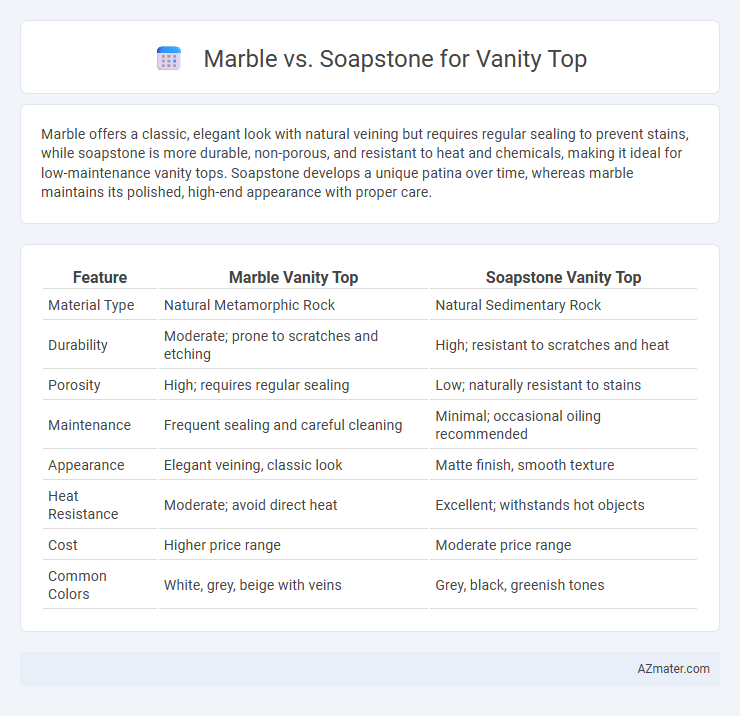Marble offers a classic, elegant look with natural veining but requires regular sealing to prevent stains, while soapstone is more durable, non-porous, and resistant to heat and chemicals, making it ideal for low-maintenance vanity tops. Soapstone develops a unique patina over time, whereas marble maintains its polished, high-end appearance with proper care.
Table of Comparison
| Feature | Marble Vanity Top | Soapstone Vanity Top |
|---|---|---|
| Material Type | Natural Metamorphic Rock | Natural Sedimentary Rock |
| Durability | Moderate; prone to scratches and etching | High; resistant to scratches and heat |
| Porosity | High; requires regular sealing | Low; naturally resistant to stains |
| Maintenance | Frequent sealing and careful cleaning | Minimal; occasional oiling recommended |
| Appearance | Elegant veining, classic look | Matte finish, smooth texture |
| Heat Resistance | Moderate; avoid direct heat | Excellent; withstands hot objects |
| Cost | Higher price range | Moderate price range |
| Common Colors | White, grey, beige with veins | Grey, black, greenish tones |
Introduction to Vanity Top Materials
Marble and soapstone are popular vanity top materials valued for their durability and aesthetic appeal in bathroom design. Marble offers a classic, polished look with natural veining, making it a luxurious choice, while soapstone provides a matte finish and excellent resistance to stains and heat. Selecting between marble and soapstone depends on factors like maintenance preferences, style, and longevity for bathroom countertops.
Overview of Marble and Soapstone
Marble is a natural stone known for its elegant veining and classic white or light-colored appearance, commonly used in luxury vanity tops due to its smooth texture and high polish potential. Soapstone, composed mainly of talc, offers a matte finish with subtle veining, providing high resistance to heat, stains, and bacteria, making it a practical and durable option for bathroom vanities. Both materials differ in maintenance needs, with marble requiring more sealing and care to prevent etching, while soapstone develops a natural patina over time, enhancing its unique character.
Aesthetic Differences: Marble vs Soapstone
Marble vanity tops exhibit a luxurious, classic appeal with their distinctive veining and wide color range, enhancing elegant bathroom designs. Soapstone offers a matte, smooth texture with subtle veining, creating a more rustic and warm atmosphere ideal for cozy, natural settings. The polished shine of marble contrasts with the soft, muted tones of soapstone, allowing homeowners to choose based on desired aesthetic and maintenance preferences.
Durability and Strength Comparison
Marble offers a classic, elegant appearance but is relatively softer and more prone to scratches, chips, and stains compared to soapstone. Soapstone ranks higher in durability due to its dense, non-porous nature, resisting heat, acidic substances, and physical impact more effectively than marble. For vanity tops, soapstone's superior strength and low maintenance make it a more practical choice in high-use bathrooms.
Maintenance and Care Requirements
Marble vanity tops demand regular sealing and prompt cleaning of acidic spills to prevent staining and etching, as their porous nature makes them highly susceptible to damage. Soapstone offers superior durability with minimal maintenance, requiring only occasional oiling to enhance its natural patina and protect against minor scratches. Both materials benefit from gentle, non-abrasive cleaners, but soapstone's resilience provides a more forgiving surface for long-term use in bathroom environments.
Stain and Scratch Resistance
Soapstone offers superior stain resistance compared to marble due to its non-porous nature, reducing the risk of discoloration from spills or daily use. Marble is more susceptible to staining from acidic substances like wine or citrus, requiring regular sealing to maintain its appearance. In terms of scratch resistance, soapstone is softer and may develop a patina over time, whereas marble is harder but can still scratch and chip under heavy use.
Heat and Moisture Tolerance
Soapstone offers superior heat resistance compared to marble, as it can withstand direct contact with hot items without damage or discoloration. Marble is more porous and sensitive to moisture, making it prone to staining and etching from water and acidic substances over time. For vanity tops exposed to frequent heat and moisture, soapstone provides a more durable and low-maintenance surface than marble.
Cost Analysis: Marble vs Soapstone
Marble vanity tops typically cost between $50 and $150 per square foot, reflecting their luxurious appearance but higher maintenance requirements. Soapstone ranges from $70 to $120 per square foot, offering durability and stain resistance at a moderate price point. Choosing between marble and soapstone depends on budget constraints and long-term upkeep preferences, as soapstone often reduces cleaning and sealing expenses over time.
Environmental Impact and Sustainability
Marble, a natural carbonate rock, is quarried extensively, often resulting in significant habitat disruption and high energy consumption during extraction and processing. Soapstone, composed primarily of talc, is mined more sustainably with lower environmental impact due to less intensive quarrying and longer durability, reducing the frequency of replacement. Soapstone's non-porous nature also decreases the need for chemical sealants, enhancing its eco-friendly profile compared to marble's higher maintenance requirements involving synthetic sealers.
Which Vanity Top is Right for You?
Marble vanity tops offer timeless elegance and a smooth, cool surface ideal for luxurious bathroom designs but require regular sealing to resist stains and etching. Soapstone provides a durable, non-porous option with natural resistance to heat, stains, and bacteria, making it low-maintenance and perfect for high-use areas. Choosing between marble and soapstone depends on your preference for aesthetic appeal versus functionality and longevity in bathroom environments.

Infographic: Marble vs Soapstone for Vanity Top
 azmater.com
azmater.com